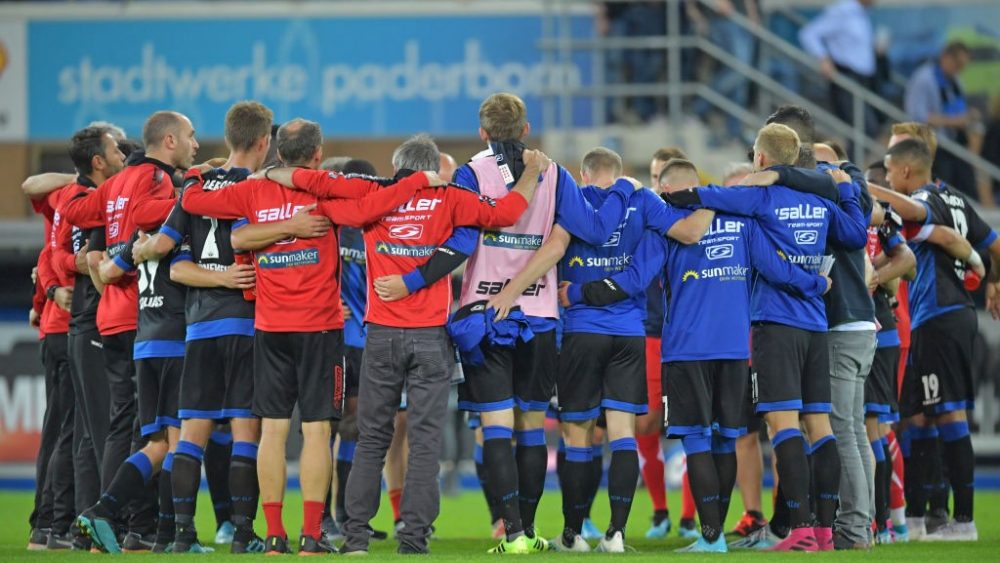Bundesliga MD06 Preview: SC Paderborn against FC Bayern Munich
Five games, one draw, four defeats, six, goals, 14 goals conceded, one point – the numbers are clear. Until now, Paderborn has won 7 points fewer than they had managed to do at this stage of the season the last time they were part of the Bundesliga five years ago.
However, they also arguably had a much easier start five years ago, facing Mainz, Hamburg, Cologne, and Hannover, relegation candidates one and all, during the first five matchdays. This time around, their road into the season was paved with much stronger teams like Leverkusen, Wolfsburg, Freiburg, and Schalke. Only the match against Hertha seemed like a level contest – which they lost nonetheless.
Paderborn comes first on most people’s list of relegation candidates despite their remarkable resurgence to top flight football over the last three years. They were relegated to the 2. Bundesliga in 2015, immediately relegated again to the 3. Liga in 2016 and by rights should have been immediately relegated again to the fourth tier in 2017, if it not been for a certain Munich based team not receiving a license for the next 3. Liga season. That being the case however, Paderborn was fortunate enough to remain in the 3. Liga and were able to move back up to the Bundesliga just as quickly as they went down over the course of the next two years.
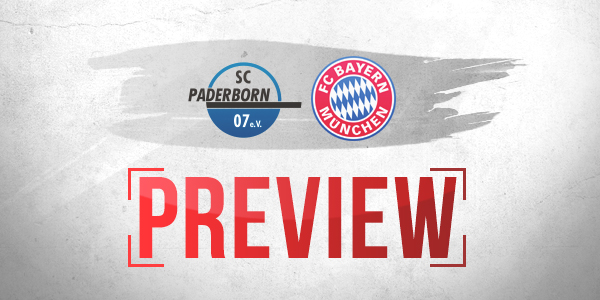
SC Paderborn – taking the elevator down and back up again
Current head coach Steffen Baumgart is an integral part of this remarkable story. He has been in the dugout for Paderborn since April 2017. Since his arrival, the only way for Paderborn has been up. He secured the straight bounce back to the Bundesliga for his club by overseeing two impressive campaigns back to back in 2017 and 2018.
The sporting backbone of Baumgart’s two successive promotions was a very vertical style of play based on pace and direct passing on the ball backed by an aggressive and well organised gegenpressing off the ball. Frequent positional changes, quick dribbles, and a generally very high pace were the signatures of his preferred style of play.
Baumgart Said before the season that he intended to carry his style of play forward to the Bundesliga. People were asked to watch enough boring football as it was and he did not want to add to their misery even more. Against this backdrop, it is all the more surprising that Paderborn’s game has seemed somewhat inhibited so far this season.
Lack of quality?
Even though Paderborn’s opening set of fixtures has been challenging, there was the chance to win more points, especially in the matches against Freiburg, Wolfsburg and Hertha. But it appears as though Paderborn are their own worst enemies at the moment. They have not yet been able to show much of their aggressive and well timed gegenpressing. Instead, their game seems hesitant and cautious and somehow restrained. Perhaps they are still showing a bit too much respect to Bundesliga sides, but the way they currently playing has caused them problems so far.
One of the issues they have concerns their possession game. Here, the team has not been able to replicate the versatility they demonstrated so often during past years. This is partly due to the departures of Bernard Tekpetay and Philipp Klement in the summer. These two midfielders were crucial linchpins in Baumgart’s tactical setup. While Tekpetay was always able to astutely link up defense and offense and was a constant source of danger on the right-hand side, Klement was the key pivot and pacemaker in the middle of the park.
Then there is the injury of Sebastian Schonlau, who added variety to Paderborn’s build-up play through his unorthodox movements and running patterns. The 25 year old just returned to first team training a few days ago. None of these absences could be adequately compensated and Steffen Baumgart’s customary 4-4-2 formation is short of some key players who made it so effective in the past.
Deficiencies against the ball
Paderborn currently struggle to create spaces for themselves in possession. Clever switches of plays that suddenly opened up whole areas of the pitch for them to exploit were a staple ingredient of their build-up play in recent seasons. Their game is much more static now. They switch play only rarely and the players in the center have difficulties in making the right decisions. Consequently, their game lacks depth. They hardly ever manage to get the ball in behind the opponent’s last defensive line. And they also do not seem to have an idea of how to properly protect the player on the ball to give him more time.
Defender Klaus Gjasula, for example, is a competent passer of the ball, but he has consistently been taken out of the game by the opponent’s gegenpressing so far. His counterpart in central midfield is Sebastian Vasiliadis, who plays much higher up the pitch and is therefore less able to take part in his team’s build-up play.
All told, the offensive efforts of the club from East Westphalia are rather predictable at present: the two full-backs Mohamed Dräger (right) and Jamilu Collins (left) are the cornerstones of Paderborn’s efforts to carry the ball forward. Both players go about this in a different way: Collins sticks to his line and tries to push ahead by dribbles and simple passes, whereas Dräger often moves inside. He too likes to dribble, but he often prefers a diagonal route towards the center. On balance, most of Paderborn’s attacks start from the outside and move in.
Problems against dominant teams
As a consequence, Paderborn’s game often lacks width, especially on the right-hand side, where not just Dräger but also Cauly Oliveira Souza, Paderborn’s regular right midfielder, often drifts to the middle. The Brazilian’s task is to create situations of numerical advantage in midfield and bring himself in positions to play the lethal deep pass as an inverse playmaker. As a result of the vacancy on the right-hand side of the pitch, most of Paderborn’s build-up play from the back goes through the left flank (45%).
All-in-all, Paderborn’s players do not (yet) appear to be in harmony within Baumgart’s preferred 4-4-2-based system. The team’s problems also include the game against the ball. So far, they have not yet been able to replicate their very effective gegenpressing of recent years this season.
The first signs of this were already visible in their first game against Leverkusen. In their current 4-4-2, Paderborn does not manage to exert pressure on teams who are flexible in build-up play and able to act under pressure. Leverkusen arranged their back rows in a 3-2 formation during build-up, allowing them a 3 vs. 2 advantage in defense. They made up their apparent 2 vs. 4 disadvantage in midfield through clever runs and quick passes, which then allowed them to have extra numbers in attack.

In the 51st minute, one of Leverkusen’s holding midfielders dropped back in between Paderborn’s two strikers, allowing him to play his pass in the space between the attack and midfield line. Leverkusen’s second holding midfielder now had several passing options available to him, which he used to create an overload on the right flank. Paderborn reacted by contracting even further, thus yielding even more space to Leverkusen on the wing. Instead of desperately trying to block the center when it was already too late, Paderborn should have attacked Leverkusen’s midfielders much earlier or defended wider to begin with. Perhaps Paderborn still has difficulties figuring out who is to mark which player in which situation. This frequently looked to be the case in the game against Leverkusen at any rate.
Failing to close down the opponent
Wolfsburg also used a 3-2 formation in build-up play and they also managed to take the sting out of Paderborn’ attacking game in doing so. Moreover, Paderborn’s defensive players were not determined enough in shuffling up to keep a compact shape, allowing Wolfsburg to quickly switch play to the wings.
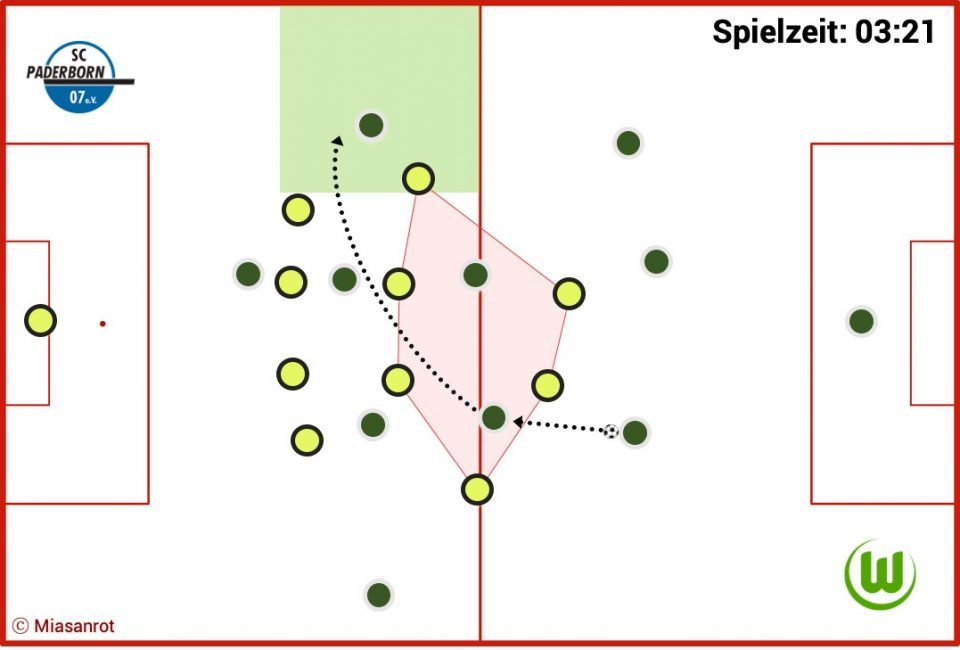
In the situation depicted above, Paderborn puts a lot of players in the middle to block Wolfsburg’s way through the center with the aim of pushing Wolfsburg onto the wings early. There they want to put pressure on Wolfsburg through forceful pressing. This seems to be a good plan to execute in the game against Bayern too because this strategy has worked against them more than once in the past. Unfortunately, Paderborn all too often allows situations to arise where the opponent can turn a numerical disadvantage in midfield into a numerical advantage on the wings because they fail to block the decisive pass to the outside despite crowding out the opponent in midfield. Every time this happens, real danger is afoot. To prevent this from occurring, Paderborn needs to close down the opponent midfielder before he can make the switch to the wings.
Facing Bayern, Paderborn’s plight is further exacerbated because Bayern is a team of immense productivity down the flanks if they are allowed space and time there. Baumgart has two options to adjust accordingly: First, he could shift to a back five to strengthen his defense in wide areas without any detriment to his preferred game of all out offensive. Second, he could pull one of his attackers back to midfield to have even more men there. But if he does neither and opts to stay with his customary 4-4-2, his players will have to be more aggressive, closer to their opponents and more mentally nimble than in the previous games.
Regardless of the game against Bayern, a certain mental inertia, inconclusiveness in their actions and deficiency in their decision making seems to have befallen Paderborn this season. Take for instance this situation in the 17th minute of the match against Wolfsburg.
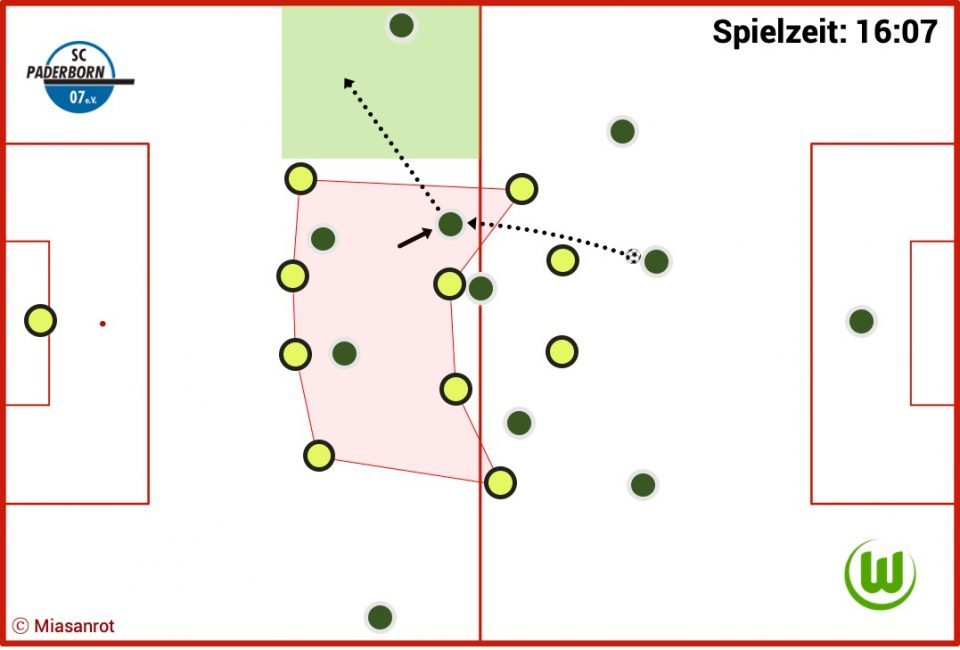
One of Wolfsburg’s attackers falls back between Paderborn’s holding midfielder, who is already marked, and their left winger. He receives the ball after an outstanding high risk pass by Guilavogui, and suddenly he has a lot of space ahead of him on the right flank. Paderborn’s players are too far apart from one another and they are also too far away from their opponents to close them down effectively. This is something they need to work on if they are to have any hopes of staying up this year.
Too steep a learning curve?
All the criticism notwithstanding, Paderborn did have the chance of a better start to the season. They are still quite dangerous on the counter. It does not take them much time at all to rush the still unorganized opponent with four or five quick players at once after winning the ball. The 1-0 against Freiburg, for example, resulted from a Paderborn counter on the break that took them 11 seconds from winning the ball at their own penalty box to scoring at the other end.
The two big areas for Baumgart and his staff to work on in the coming weeks are: 1. to polish their team’s gegenpressing skills – the aforementioned deficits in marking and closing down players in midfield first of all – and, 2. to improve their ability to create and use chances in possession. They cannot yet cope with the speed and precision that is the standard in the Bundesliga. However, theirs is not a lost cause. They have a robust foundation in place and all it takes is a bit more determination in pressing and marking and some adjustments to their 4-4-2. Nevertheless, they should really set their minds to it and make substantial improvements before long if they want to prevent a season-long stint in the relegation places.
Bayern’s tactical options against Paderborn
Paderborn’s current condition allows Bayern to draw several conclusions. They will need to play with a high tempo and should aim to be in control in midfield. Paderborn’s 4-4-2 is normally very compact and stable. Their problems only occur when they are put under pressure and drawn out to the wings. Bayern should consider some slight adaptions in midfield to prepare for this and be best able to capitalize on Paderborn’s weaknesses.
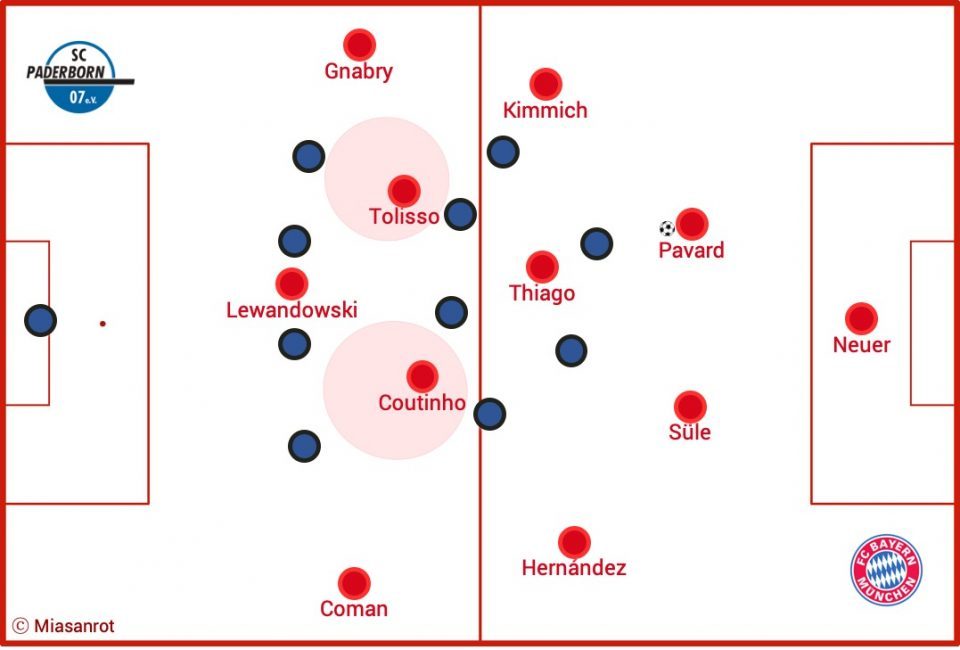
To clarify Paderborn’s strengths in pressing, we draw on Niko Kovač’s early season 4-3-3 formation. If Bayern were to opt for this setup, they would most likely be confronted with difficulties in build-up play. Even if both number eights carefully watched out for the distance to their holding midfielder, the default player positioning in Paderborn’s 4-4-2 would probably still enable them to mark Bayern’s offensive midfielders and take their single holding midfielder out of the game. In comparison to Leverkusen’s and Wolfsburg’s setup with two holding midfielders, Bayern would be a man short there and thus find it much more difficult to effectively build up through the center. But with just one small adjustment, the 4-3-3 might suddenly become interesting again.
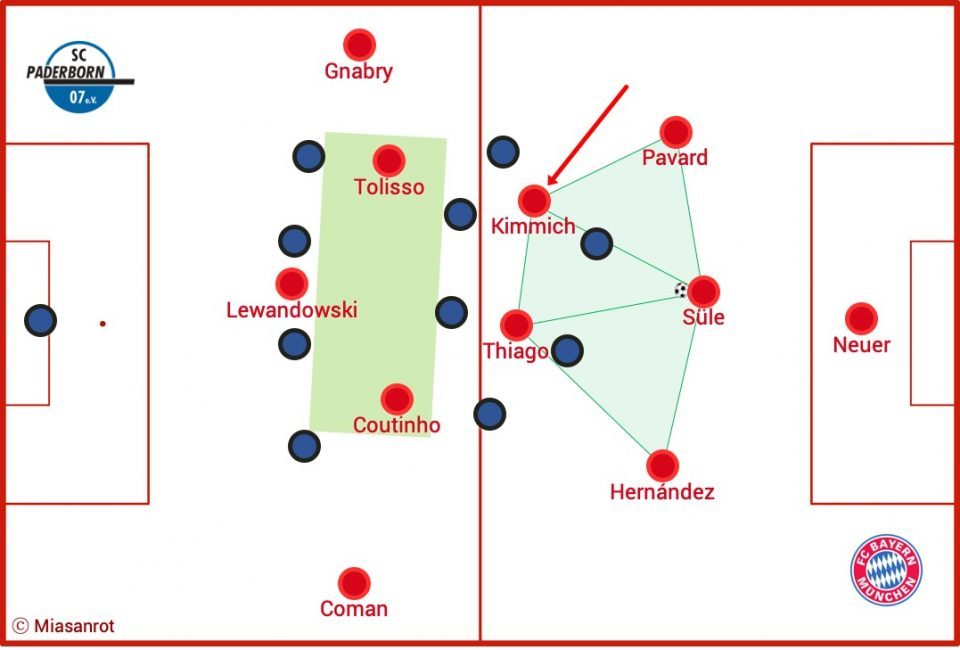
If Kimmich were to shift to midfield and Hernández to remain deep when Bayern are in possession, Bayern would emulate the same 3-2 formation in build-up that Leverkusen and Wolfsburg used against Paderborn to good effect. Theoretically, Paderborn would have a 6 vs. 5 advantage in offense now, but they would also have fewer men in defense than Bayern in offense. This would ask questions of their holding midfielders (do we move up? Do we fall back?) that Thiago and Kimmich could use to their advantage.
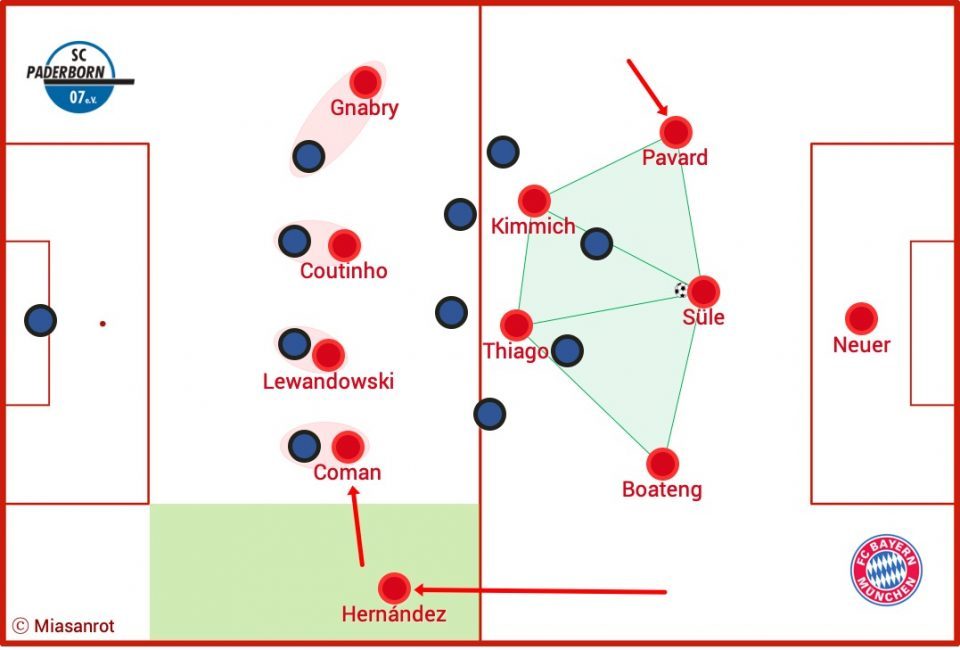
Bayern could of course also produce the same effect with their recent 4-2-3-1 formation. This formation would not just grant them the option to position two very capable defenders in the half spaces of their defensive line, but also to create considerable space on the left wing. In the game against Schalke, Paderborn repeatedly had problems in dealing with situations where Schalke’s wingers tucked in and their full-backs overloaded the flanks. Paderborn struggled with properly handing over and picking up Schalke’s players. Bayern could copy this tactic from Schalke without needing to forego playing through the middle as their technically highly skilled duo of Thiago and Couthino would also enable them to build up through there. Moreover, Kingsley Coman could swap sides with Serge Gnabry if Niko Kovač intends to continue with Gnabry playing in a more central position and Coman sticking to the flanks.
A 3-2-4-1 out of a 4-3-3?
Arguably the most attack-oriented option available to Kovač would be to go into the game with a formation with Thomas Müller and Philippe Coutinho starting as the two number eights. Both Müller and Couthino could act as a two pronged feeding machine for Lewandowski’s insatiable appetite for goals. It would be very interesting to see how the two midfielders would combine against a compact and deep sitting opponent. Their qualities between the lines could pay off hugely in a game like this.
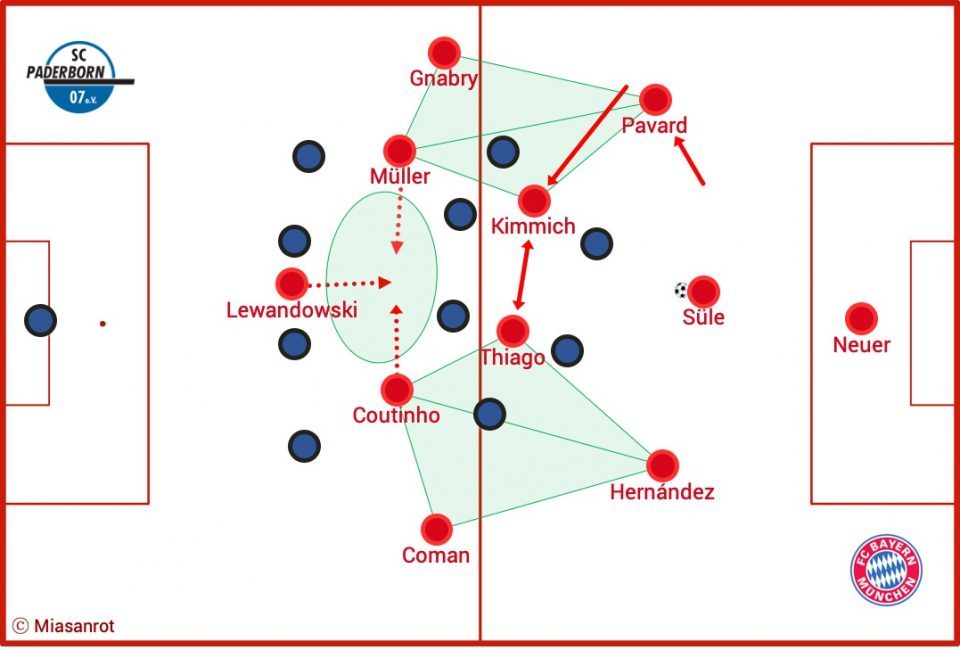
What better time to test starting Müller and Couthino than in a game against a newly promoted underdog? Kimmich would situationally move up next to Thiago in defensive midfield to support him in building up Bayern’s game.
Paderborn’s aggressive pressing can ask questions of any opposition. But the game on Saturday is Bayern’s to lose. Much will depend on their preparation and ability to stay focused. They are not just much stronger individually, but also have stepped up their build-up play in recent weeks. A lot of Bayern’s strengths seem to ideally match Paderborn’s weaknesses, for example their preference to initiate their build up through the center before going wide.
The one area Bayern still need to work on for this game, and beyond, is their coordination in the final third. In the match against Cologne for example, Lewandowski, Perišić and Couthino were too close to each other on many occasions. Coutinho specifically benefits from space to roam in and his teammates making themselves available for a pass – and he gets neither if they keep coming to close to him.
This may also be due to the fact that the team has yet to get accustomed to a player like Coutinho. Bayern have never had a player of quite his technical skills in tight spaces who so often seeks to link up in combinational play with his teammates to create chances. Now Bayern need to properly integrate Coutinho in their positional play and improve in the process because their game still lacks the finishing touch in the final third.
More depth and creativity in the final third
Only 66% of Bayern’s shots on target come from open play. RB Leipzig (83%), Dortmund (74%) and a good deal of the international competition are significantly ahead of Bayern in this regard. Only Atletico (60%) has a lower value. It is both noteworthy and important that Bayern is effective from set pieces, but it is also a verdict on their game that 33% of their chances result from these.
Against Cologne, eleven shots on goal in the first half lead to an expected goals (xG) tally of 0.9 (0.08 xG per shot). A major focus of Bayern’s training in the coming weeks and months should be on improving their variability and depth in the final third.
Paderborn will certainly try to disrupt Bayern’s build-up play through the center with a lot of passion and running. Bayern will need to answer with creativity in offense if they are to take home a resounding victory.



